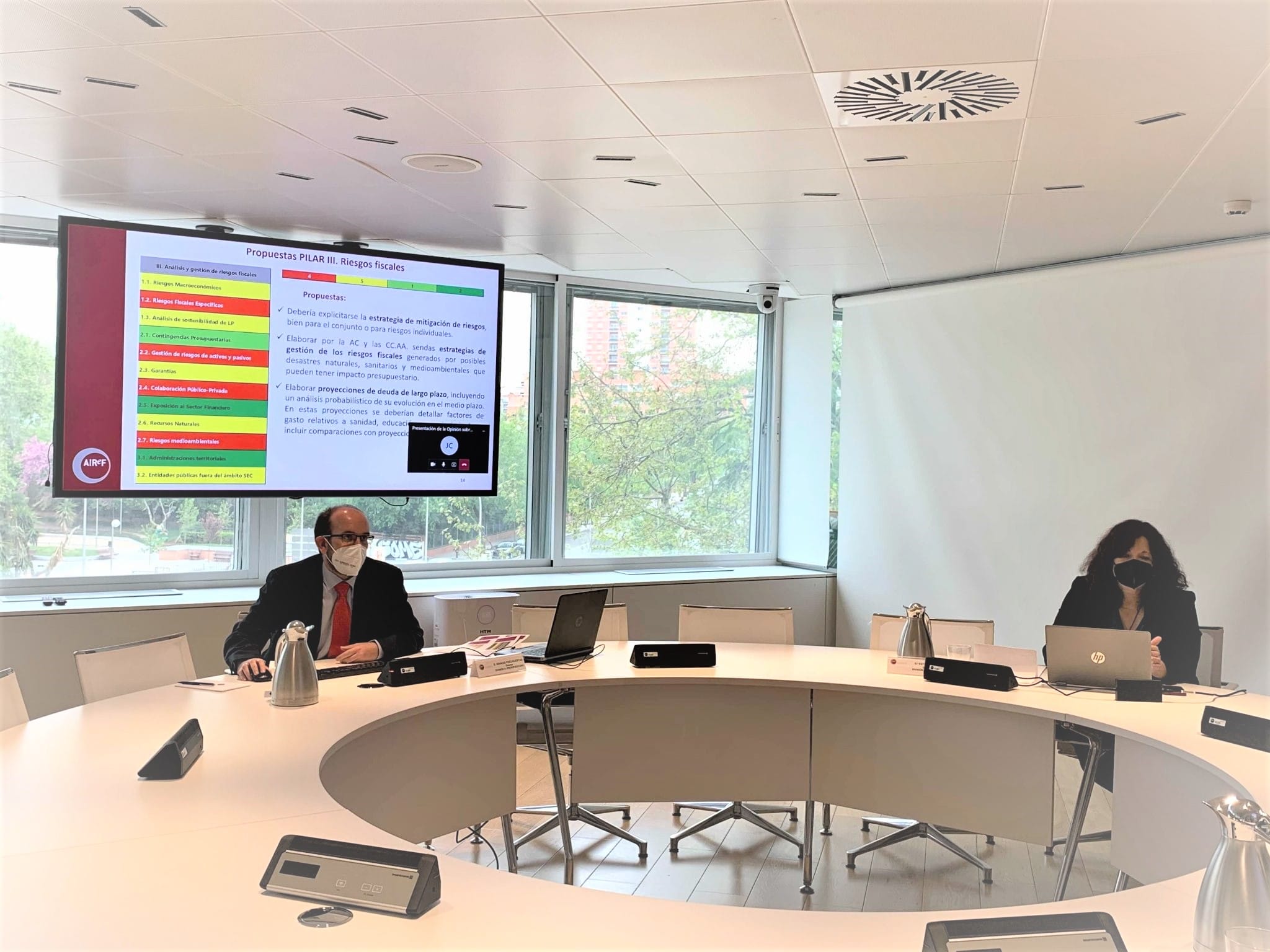- The analysis by the Independent Authority for Fiscal Responsibility (AIReF) puts Spain in a similar position to that of its peer countries in fiscal transparency in the General Government
- Relevant areas for improvement in medium-term orientation and fiscal risk management are identified
- AIReF proposes ensuring the consistency and reconciliation of the main budget planning documents
- It suggests drawing up a report on specific fiscal risks and designing management and mitigation strategies
The Independent Authority for Fiscal Responsibility (AIReF) today published on its website its Opinion on Fiscal Transparency in the General Government in Spain, in which it conducts an analysis that places Spain in a similar position to that of its peer countries, although it identifies relevant areas for improvement in medium-term orientation and fiscal risk management. AIReF includes a series of proposals, including the design of a comprehensive medium-term budgetary framework for the General Government as a whole and for each administration.
Raising the transparency of public finances is one of AIReF’s strategic objectives as it is a powerful channel for improving the efficiency of public spending and for promoting the good design and sustainability of public accounts.
In the analysis, AIReF has assessed a total of 36 indicators following IMF methodology, organised into three pillars:
– Fiscal reports
– Fiscal forecasting and budgeting
– Fiscal risk analysis and management
In Pillar I, AIReF observes best practices, in line with its peer countries. According to the analysis, the reports generally provide a comprehensive, relevant, timely, and reliable overview of the state of public finances. This has been helped by the need to comply with international and EU standards. The most notable weaknesses identified by AIReF relate to the limitations of the explanations on historical revisions.
In Pillar II on forecasting and budgeting, AIReF found most of the practices to be good or advanced both for the Central Government and the Autonomous Regions, although it identified significant limitations in medium-term budgeting, compliance with the timetable for preparing and submitting budgets and in the reconciliation of forecasts. According to AIReF, the budgetary process is fragmented, and it is not possible to ensure consistency between its main elements: the Stability Programme Update, the budgets of each administration and the budgetary plan.
In Pillar III on the identification and management of risks to public finances, AIReF notes significant room for improvement. In particular, there is a need for a more exhaustive analysis of the risks that might affect public finances and the design of risk management strategies. Although the Central Government has improved over recent years in its analysis and management of the risks associated with exposure to the financial sector and to the Territorial Administrations, the implications of the risks associated with the macroeconomic scenario and contingent liabilities, such as guarantees and public-private partnerships, for the public accounts and debt are scarcely analysed. AIReF also notes the absence of any analysis of long-term sustainability at a regional level.
Proposals
On the basis of the analysis performed, AIReF makes a series of proposals aimed at improving fiscal transparency in each one of the pillars. In order to improve transparency in Pillar I, AIReF believes that the National Statistics Institute (INE) and the General Intervention Board of the State Administration (IGAE) must persevere in their efforts to improve transparency and the understanding of historical revisions. In addition, AIReF proposes approving the internal regulation of the Technical Committee on National Accounts, giving its operation greater transparency by, at least, publishing its decisions.
With the aim of boosting transparency in fiscal forecasting and budgeting (Pillar II), AIReF proposes developing a comprehensive medium-term budgetary framework for the General Government as a whole and for each administration. This proposal involves expanding the content and detail of the Stability Programme Update to include all items of a medium-term fiscal strategy; preparing and publishing medium-term budgetary scenarios with at least the content and detail provided for by the General Budgetary Law; and communicating to the ARs the fundamental elements for drawing up their medium-term frameworks.
Within Pillar II, AIReF also suggests ensuring the consistency and reconciliation of the main budgetary planning documents (the Stability Programme Update, the General State Budget and the Budgetary Plan) by providing forecasts in national accounting terms in the budgets and further detail by sub-sector in the Stability Programme and the Budgetary Plan. It also proposes complying with the obligation to submit the draft budgets according to the timetable provided for in the legislation, unless there is a legal reason for not doing so, and promoting a new strategic and budgetary planning framework linked to public policies.
Finally, in order to improve transparency in fiscal risk analysis and management (Pillar III), AIReF makes several proposals, such as preparing a report on specific fiscal risks setting out the possible risks that may affect the fiscal projections. According to the institution, this report should include information on the risks arising from the financial sector, the borrowing of public companies, natural disasters (including public health disasters), public-private partnerships, guarantee programmes, loans and rulings, asset and liability management and environmental risks.
Once the fiscal risks have been identified and analysed, AIReF believes that it is important to assign probabilities to their materialisation and to quantify their impact. Furthermore, the risk mitigation strategy should be made explicit, either for the risks as a whole or for individual risks.
In addition, AIReF believes that the Central Government and the ARs should develop strategies to manage the fiscal risks generated by possible natural, health and environmental disasters that may have a budgetary impact. Finally, it recommends preparing long-term debt projections, including a probabilistic analysis of their evolution in the medium term. These projections should detail expenditure factors related to health, education and ageing, and include comparisons with previous projections.







